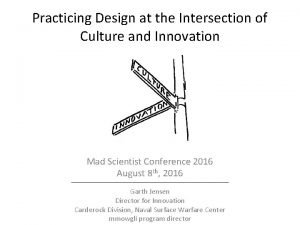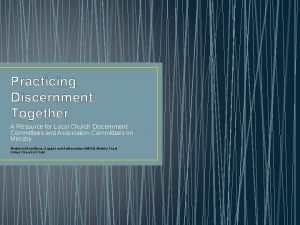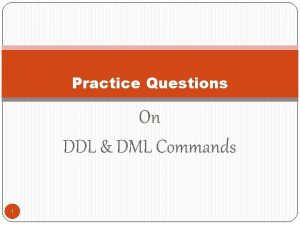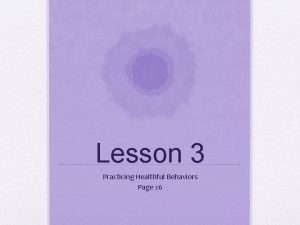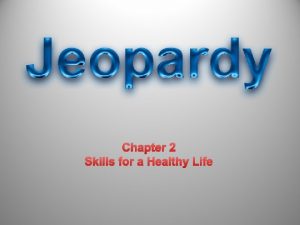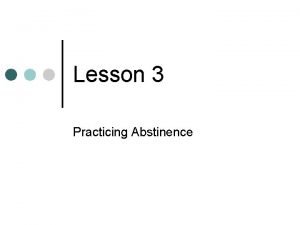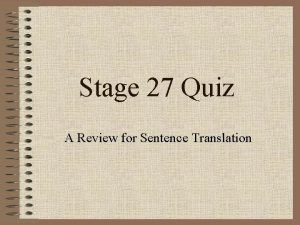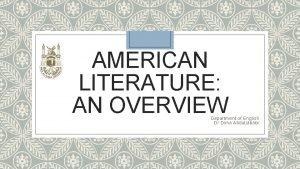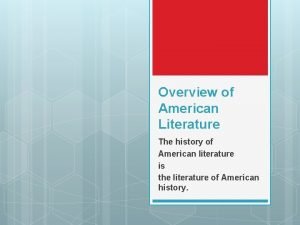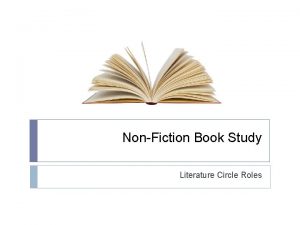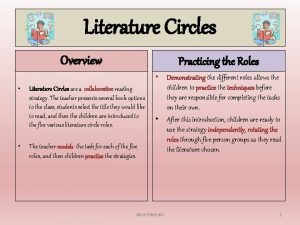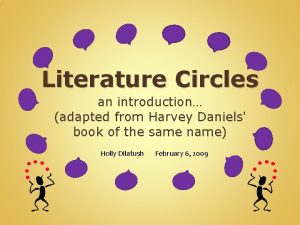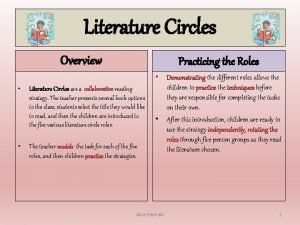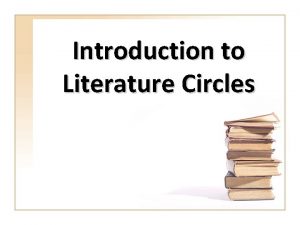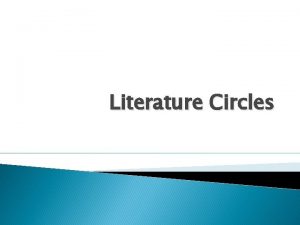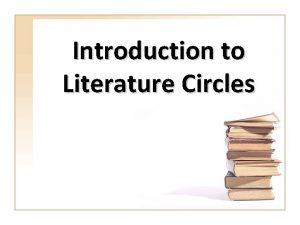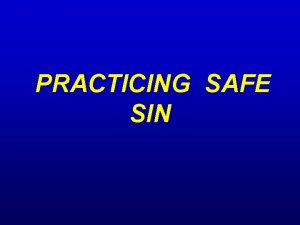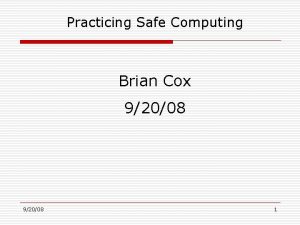Literature Circles Overview Practicing the Roles Literature Circles











- Slides: 11

Literature Circles Overview Practicing the Roles • Literature Circles are Literature Circles a collaborative reading strategy. The teacher presents several book options to the class, students select the title they would like to read, and then the children are introduced to the five various literature circle roles. • The teacher models the task for each of the five roles, and then children practice the strategies. • Demonstrating the different roles allows the children to practice the techniques before they are responsible for completing the tasks on their own. • After this introduction, children are ready to use the strategy independently, rotating the roles through five person groups as they read the literature chosen. Alice Kheirabi 1

Literature Circle Roles Stellar Summarizer Artful Artist • Retell the story in your own words. Draw anything about this chapter that you liked. It could be: • Include three main events that happen in the story v the setting v a problem • Make sure that they are important parts. v an exciting part v a surprise • Does the group agree? v a prediction of what will happen next Alice Kheirabi 2

Literature Circle Roles Passage Master Word Wizard Your job is to pick passages from the section that you read this week that you would like your group to talk about. Choose passages that carry some significant meaning to the story. Here are some ideas to help you: important background information • figurative language • descriptive/imagery • dialogue • foreshadowing • suspenseful • surprising • funny/amusing • element of plot Look for special words in the story. Find at least five words for each session. Words that are: q new q different q funny q strange q difficult Record: Word Page Why I picked it Alice Kheirabi 3

Literature Circle Roles Literary Critic Discussion Director As literary critic, your job is to analyze the chapters read answer the following for EACH CHAPTER read: . Characters: Are there any new characters introduced in these chapters? Who are they? WHY did author choose to introduce them? Conflicts? What are the conflicts? Conflicts can be between people, within a person’s own mind, or between a person and outside forces? Is this conflict internal or external? Setting: Where and when does each scene take place? Why does this matter!? ! Theme: What point is the author trying to make so far? In other words, what is the author trying to teach us? !? Symbols: Are there any symbols, words, or phrases that the author uses repeatedly? For example, in the book, Hatchet, the hatchet symbolizes survival for Brian. Purpose: What’s the author’s main purpose of putting in these chapters? What is he trying to say, or how is he advancing the plot of the story? Write down some clever questions that you want to talk about with Alice Kheirabi the group. At least 3 questions! 4

General Literature Circle Structure • 5 -10 minutes: Mini-lesson on thinking and social skills e. g. Refining discussion skills: creating deeper comprehension • 20 -30 minutes: Group meetings (and/or reading time) • 5 -10 minutes: Sharing/Debriefing; Evaluate any emerging themes Alice Kheirabi 5

Rules • Gather together • Start promptly • Discuss quietly and politely • Listen carefully to group members Do any of the characters change in the story? What caused them to change? How are you different from one of the characters? Explain. Respond to a part in the book that. . . q Makes you laugh q Make you wonder q Surprises you q You don’t understand q Has interesting words q Makes you sad or upset q Was your favourite part q Reminds you of something that has happened in your life If you could trade places with one of the characters, which one would it be? Discussion Starters q “In my opinion. . . ” q “I’d like to add. . . ” q “I agree because. . . ” q “I disagree because. . . ” q “I don’t understand. . . ” q “I am confused about. . . ” q “On page. . . ” Was there a character you didn’t like? Why didn’t you like this character? If you had been the main character in this story, would you have acted differently? Explain how or why. What was the message of the story? What particular part helped you to work it out? What do you think was the best part in the story? Would you recommend it to someone else? Why or why not? Would you like to read something else by this author? Why or why not? Alice Kheirabi 6

Reflection • Children learn to take responsibility for their own learning. • This is reflected in how effectively they make choices and take ownership of their literature circle group. • They quickly take charge of their own discussions, hold each other accountable for their individual reading and how they carry out their role. • The positive peer pressure that the members of each group place on each other contribute to each child's accountability to the rest of the group. Alice Kheirabi 7

Reflection • When children engage with texts and one another in these ways, they take control of their literacy in positive and rewarding ways. • Choice of reading materials and choice of language to discuss what was read, provide sopportunities for the children to improve their levels of both fluency and literacy. Alice Kheirabi 8

Why Literature Circles ? The Rationale Behind Them • • Promote a love of literature and positive attitudes toward reading. Reflect constructivist, child-centered model of literacy Encourage extensive and intensive reading Invite natural discussions that lead to student inquiry Support diverse responses to text Provide choice and encourage responsibility Expose children to literature from multiple perspectives Nurture reflection and self-evaluation Source: Literature Circles and Response, Hill, Johnson, Noe Alice Kheirabi 9

Research on Literature Circles • • • Greater gains in reading comprehension (Klinger, Vaugn & Schumm, 1998) Improved reading achievement in high poverty schools (Knapp, 1995) Enhanced student motivation to read (Guthrie & Alvermann, 1999) Benefits for second language learners (Mac. Gillivray, 1995) Increased student enjoyment of and engagement in reading (Fox & Wilkinson, 1997) • Increased multicultural awareness (Hansen-Krening, 1997) • Promoted other perspectives on social issues (Noll, 1994 Alice Kheirabi 10

Without further adieu…. Alice Kheirabi 11
 Practicing design
Practicing design Practicing discernment
Practicing discernment Practicing ddl commands
Practicing ddl commands Practicing healthful behaviors
Practicing healthful behaviors The life skill using community resources means
The life skill using community resources means Chapter 8 lesson 3 practicing abstinence
Chapter 8 lesson 3 practicing abstinence Modestus tam miser erat ut rem diutius ferre non posset.
Modestus tam miser erat ut rem diutius ferre non posset. American literature overview
American literature overview American literature overview
American literature overview Literature circle rules
Literature circle rules Artful artist literature circle
Artful artist literature circle Literary luminator
Literary luminator
